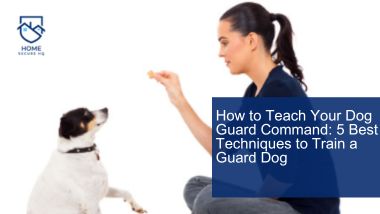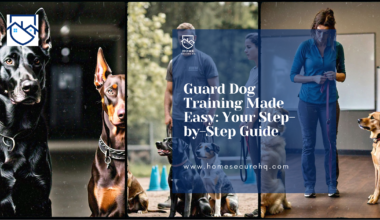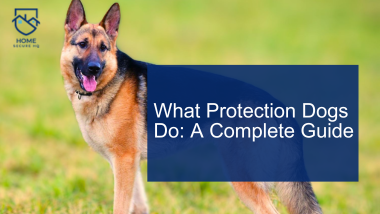Is there a time you felt that extra comfort knowing your dog got your back? Want to know how to teach your dog guard command with these 5 best techniques? Imagine how much more confident you’d feel if they could respond to a clear command to guard when most needed.
It’s not just about having a protective dog it’s about having a well-trained one that knows exactly when to act and how to respond.
But with patience, consistency, and the right techniques, teaching your dog to follow a guard command can be a rewarding experience for both of you.
Join me, as I share with you 5 best techniques to help your dog learn this essential skill. If you are looking to train your dog for personal protection or you just want to teach your dog a new skill, you’ll find what you need right here to teach your dog in a way that’s both safe and effective.
Why Teach Your Dog the Guard Command

Training your dog with a guard command isn’t only about security. It helps your dog understand boundaries, manage emotions, and respond to your guidance instead of acting out on instinct. Knowing your dog can guard on command gives you peace of mind, whether you’re home or away.
The Key Benefits of Guard Command Training
- Controlled behavior: Your dog only guards when asked, avoiding unnecessary aggression or barking.
- Increased safety: With proper training, your dog will know when to respond and when to stand down.
- Deeper trust: The training process strengthens the bond between you and your dog, as they learn to trust your instructions.
Teaching your guard dog command transforms your dog from a random barker into a calm protector, one who knows exactly when to intervene and how to respond.
How to Evaluate Your Dog’s Readiness for Guard Training

Before diving into guard command training, evaluating if your dog is ready for this important role is crucial. Not every dog has the temperament or drive to be a guardian. Start by observing your dog’s behavior in various situations.
Look for Key Traits:
A. Confidence: Does your dog show self-assurance in unfamiliar environments? Confident dogs are more likely to excel in guarding roles.
B. Alertness: Notice if your dog is attentive to their surroundings. A good guardian should naturally keep an eye on things.
Conduct a Few Tests:
- Introduce New Scenarios: Expose your dog to different sounds, sights, and people. Observe how they react. Do they bark, growl, or remain calm? Their response will help you gauge their readiness.
- Evaluate Past Training: Consider their previous training experiences. A dog with a solid foundation in basic obedience will adapt more quickly to guard training.
Evaluating these aspects will ensure that you embark on this journey with a dog well-suited for the task.
Essential Skills for Laying the Groundwork in Guard Training
Once you’ve assessed your dog’s readiness, it’s time to build a strong foundation before initiating guard training. This stage is about establishing essential skills that will benefit your dog throughout their training journey.
Start with Basic Obedience:
A. Commands Like Sit, Stay, and Come: These are crucial for any dog, but especially for those in guard training. A dog that listens to basic commands is easier to control in potentially stressful situations.
B. Impulse Control: Teaching your dog to wait patiently for a command can help them remain calm and focused when distractions arise.
Build Trust and Bonding:
- Positive Reinforcement: Use treats and praise to encourage good behavior. The more your dog trusts you, the more likely they are to respond positively to commands.
- Engage in Fun Activities: Spend quality time together through play and walks. This helps strengthen your bond and makes training sessions more effective.
Practice Socialization:
A. Introduce Your Dog to Different Environments: Expose them to busy streets, parks, and various people. This experience will help them become adaptable and confident in their surroundings.
B. Interaction with Other Dogs: Controlled playdates with other dogs can teach your dog how to react appropriately in various social situations, further enhancing their skills.
By focusing on these essential skills, you’ll prepare your dog for a successful transition into guard training, ensuring they are confident and well-equipped for the task ahead.
Best Techniques to Teach Your Dog the Guard Command

Once your dog is ready, these five techniques will help them learn the guard command effectively. You’ll need patience and practice, but these methods are easy to follow and will give your dog the tools they need to guard calmly.
1. Boundary Guarding
This technique teaches your dog to guard a specific area, such as a doorway or gate.
- Start by leading your dog to the boundary and ask them to stay.
- Say “guard” when they remain focused on the area.
- Gradually introduce distractions to test their focus.
Dogs learn to associate guarding with specific spaces, ensuring they understand where protection is needed.
2. Bark on Command
Training your dog to bark on command helps prevent unnecessary barking while ensuring they alert you when needed.
- Say the word “bark” while encouraging your dog to make a noise (you can knock on a door to trigger barking).
- Reward them when they bark in response to the command.
- Introduce the quiet command to stop barking on cue.
This technique teaches your dog to bark with purpose, not just out of excitement.
3. Responding to Signals
Train your dog to react to specific sounds or signals, like a raised hand or a doorbell ringing.
- Simulate a situation (like ringing the doorbell) and say “guard” when your dog notices the noise.
- Reward them for focusing on the sound and staying alert.
- Practice regularly with different signals to reinforce the behavior.
This method teaches your dog to respond to subtle cues, ensuring they stay alert in real-world scenarios.
4. Identifying Strangers
Help your dog learn to recognize unfamiliar people by using staged encounters.
- Have a friend act as a stranger and approach your home.
- When your dog reacts, use the “guard” command.
- Reward your dog for alerting you but staying calm.
This technique ensures your dog knows when to be cautious without becoming overly aggressive.
5. Guard and Release
Your dog must know when to stop guarding to avoid unnecessary tension.
- Use the “guard” command and wait for them to react.
- Introduce a release command like “okay” to signal the end of guarding.
- Reward your dog for following both commands correctly.
Guarding is only useful when it’s under control. The release command keeps your dog calm and obedient.
Handling Common Guard Training Challenges
Training won’t always go smoothly some dogs might struggle to understand the commands or become too protective. Here are a few common challenges and how to address them.
i. Problem
The dog ignores the guard’s command.
ii. Solution
Go back to basic obedience exercises to reinforce focus.
i. Problem
The dog becomes overprotective.
ii. Solution:
Use the release command frequently to maintain control.
i. Problem:
The dog struggles with distractions.
ii. Solution:
Gradually introduce distractions, starting with low-intensity situations.
Patience is key. Your dog will need time to adjust and fully understand the commands. Stick with it, and the results will follow.
Reinforcing Guard Training for Long-Term Success
Guard training isn’t a one-and-done process. It requires regular practice to keep your dog sharp and responsive. Integrating the guard command into your daily routines ensures that your dog remains consistent.
Tips for Long-Term Training Success
- Practice regularly: Use the guard command during everyday situations to reinforce learning.
- Keep sessions short: 5–10 minutes a day is enough to maintain skills.
- Vary rewards: Use treats, toys, and verbal praise to keep your dog engaged.
Training should always feel rewarding for both you and your dog. Keep it fun, and your dog will stay motivated.
Conclusion
Teaching your dog the guard command isn’t just about safety it’s about building a deeper bond. With time, patience, and the right training techniques, you’ll have a dog that knows when to protect and when to relax.
It’s a partnership built on trust, communication, and teamwork. For more dog training tips, read this article and give your furry friend the tools they need to thrive!








5 comments
Blue Techker Very well presented. Every quote was awesome and thanks for sharing the content. Keep sharing and keep motivating others.
Thank you
Lois Sasson This was beautiful Admin. Thank you for your reflections.
Thank you
you are in reality a just right webmaster. The website loading speed is amazing. It seems that you are doing any distinctive trick. In addition, The contents are masterwork. you’ve performed a fantastic process on this matter!
Comments are closed.